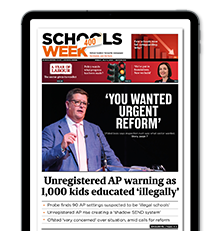We had a general election mid-2024 (With insights like that, you can see why I got hired…), so you might expect the months since to have been full of fizz and vigour and new ideas. Instead we have seen a very calm and steady approach from the department for education, reflecting education’s low status in Labour’s manifesto.
The exception, of course, is VAT on private schools, causing much sound and fury, but affecting few. Let us move on.
So too with Ofsted’s Big Listen earlier this year. For sure, it set a new tone, but inspectors are still inspecting classes and time will tell if anything has really changed.
In truth, the problems we had at the start of the year are the problems we have at the end of the year. Too many children are not in school, disadvantaged children do a lot worse, and secondary teachers are too hard to hire.
School attendance is improving, but progress is slow. At 5.9 per cent, the current absence rate is better than last year’s 6.3 per cent. Given that absence doubled during Covid however, we have a long way to go.
There are no strong regional patterns, and the issues appear nationwide, irrespective of income or ethnicity. As my colleague and fellow Schools Week contributor Ed Dorrell remarked in these pages a year ago, this issue “will take many years, a lot of hard work and substantive investment to resolve”.
Like my LSE colleagues, I fear absences will remain high so long as the Covid generation remain in school. They look like a scarred generation in so many ways. It will, as ever, fall to Further Education to try to pick up the pieces and to piece together new routes to opportunity for these young people. I hope they succeed.
Pretty much any way you look at it, the disadvantage gap is worse than before Covid. The Education Policy Institute report that the early years gap is high but falling quite sharply, the primary school gap is steady if elevated, and the secondary school gap is still growing.
Recruitment, meanwhile, is in a dire situation. To be sure, there are signs of recovery in secondaries. This year’s target was missed by 40 percent, rather than 50 per cent least year.
It isn’t rocket science; it is Economics 101
But primary recruitment, which had been holding steady, has been missed by 12 per cent, the worst since comparable records began in 2010/11.
Bully for PE though, which recruited 18 trainees for every 10 needed.
Now for sure, there are issues with workload and behaviour, and we need to tackle those. But call me a simple-minded economist all you like, the hill I’m willing to die on is that we will not recruit enough secondary school teachers unless we pay them more.
In 2010 the median teacher salary was £36,756. The Bank of England says that inflation means that that figure should be £54,339 today. If only, eh? Today’s median salary is £46,525 – almost £8,000 adrift.
Guess what? If you cut salaries by £8,000, you won’t recruit enough teachers. It isn’t rocket science; it is Economics 101, week 1. Sadly, the new government shows no more willing to face this fact than the last one.
Looking ahead, the biggest policy development of 2025 is likely to be Francis review of curriculum and assessment’s report. But it only promises ‘evolution, not a revolution’.
So we are not going to have Dearing-style specialisation from age 14. GCSEs and A levels will stay. The biggest moves are likely to be in respect of the plethora of vocational qualifications.
Maths to 18 is presumably dead. After all, it would be odd to kill it in the first year of a government only to resurrect it in the second.
Oh, and ‘balanced scorecards’ will be introduced, changing little on the ground.
Absences will no doubt continue to decline and the disadvantage gap will remain elevated. Recruitment will continue to be awful.
I think I will be able to resubmit this column in a year’s time.











Your thoughts